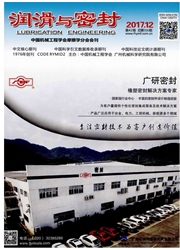

 中文摘要:
中文摘要:
以正交面齿轮传动系统为研究对象,建立了考虑齿面摩擦激励的面齿轮传动系统非线性动力学模型,基于4~5阶的自适应变步长的龙格库塔法对该模型进行数值仿真求解,结合分岔图、时间历程图、poincare图等分析齿面摩擦系数对系统的振动特性的影响,并研究不同参数对系统响应发生倍周期分岔时摩擦系数临界点的影响。结果表明:系统响应随齿面摩擦系数的增大依次呈现出单周期简谐响应、倍周期次谐响应、混沌响应;面齿轮齿宽和圆柱齿轮驱动扭矩越大,系统响应发生倍周期分岔时的摩擦系数临界点数值越大,且随着齿宽和驱动扭矩的增大,其摩擦系数临界点变化曲线斜率越小,驱动扭矩对其变化曲线斜率较齿宽影响大;面齿轮齿数和系统齿侧间隙越大,系统响应发生倍周期分岔时的摩擦系数临界点数值越小,其摩擦系数临界点变化曲线斜率随面齿轮齿数增大而减小,而齿侧间隙对其变化曲线斜率基本没有影响。
 英文摘要:
英文摘要:
Taking the orthogonal face gear drive system as the research object,a nonlinear dynamic model,in consideration of the tooth surface friction,has been established of the face gear drive system.A numerical simulation has been performed to solve the model by Runge Kutta method with variable step size adaptive4~5order based on the combination of bifurcation diagram,time history diagram,and poincare diagram to analyze the influence of the vibration characteristics of gear tooth friction coefficient on the system,followed by a study on the influence of different parameters with period doubling bifurcation on the critical point of friction coefficient.The results show that the response of the system increases positively with the increase of the friction coefficient of the tooth surface,successively making the system response in a state of a single period harmonic response,a period doubling subharmonic response and a chaotic response.The greater the gear tooth width and the driving torque of the cylindrical gear,the greater the critical coefficient of friction coefficient will be,with the system responding to the period doubling bifurcation.With the increase of tooth width and driving torque,the smaller the slope of the critical coefficient of the friction coefficient,the smaller the slope of the driving torque will be to the width of the tooth.The larger the number of face teeth and the greater backlash of the system,the smaller the critical point of the friction coefficient of the system will be when the period doubling bifurcation occurs.The slope of the friction coefficient critical point change curve decreases with the increase of the gear teeth number,with no influence of the tooth side gap on the slope of its change curve.
 同期刊论文项目
同期刊论文项目
 同项目期刊论文
同项目期刊论文
 期刊信息
期刊信息
